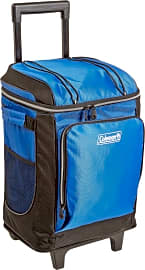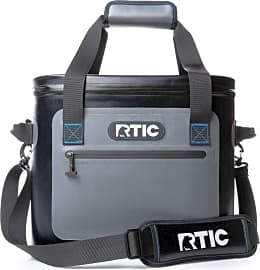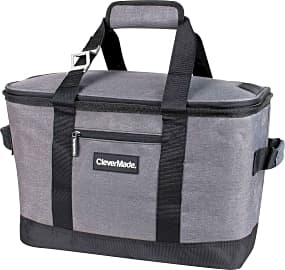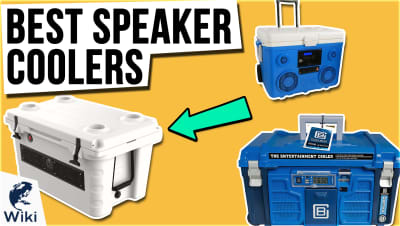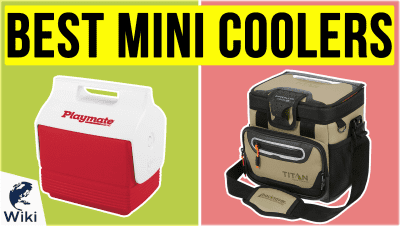The 10 Best Soft Coolers

This wiki has been updated 40 times since it was first published in April of 2015. If you're looking to upgrade your on-the-go food and beverage storage from standard grocery bags, consider an insulated option, like one of these soft coolers. They're lighter and easier to store than the hard, molded options, but can still maintain the temperature of whatever you load them up with. We've ranked them by ease of portability, storage capacity, and how long they keep things cold. When users buy our independently chosen editorial recommendations, we may earn commissions to help fund the Wiki.
Editor's Notes
April 15, 2019:
When evaluating the best soft-sided coolers, we balanced it's ability to insulate with other factors such as price and functionality. We removed the Arctic Zone Pro because of concerns about the outside fabric and strap shredding too easily. We added the Clever Made Snap Basket in its place for being equally budget-friendly and being constructed with rugged rip-stop polyester.
Despite it's reputation for keeping ice frozen for days, the Yeti Hopper Two had a high spot on the list, but would have ranked higher if it were more reasonably priced. The AO canvas took the top spot for providing a full day of frozen ice without bothersome condensation forming on the outside, and offering impressive durability at a more attainable price.
Built For Travel: The Soft Cooler
If you live in a smaller home or an apartment, space is at a premium.
When choosing between a hard-sided "ice chest" style of cooler and a soft-walled, more bag-like cooler, you're going to have to accept something right from the start: soft coolers almost always have a smaller capacity than their boxy, hard walled counterparts.
Softy sided coolers are all about mobility. Unlike large, unwieldy ice chests, these coolers are designed to be brought along with you, whether that means carried in your arms, tucked under a seat of the van, or secured in the bow of your boat or the back of a canoe.
Soft coolers are useful for myriad purposes, but not all soft coolers are suitable for the same uses. Unlike hard sided coolers, which tend to be simply larger or smaller cubes (or rectangular prisms, to be precise), soft coolers are more often than not purpose built, allowing a user to choose the soft cooler that best fits a person's preferred activities.
For example, some soft coolers feature backpack style harnesses. These coolers are often the smallest in terms of capacity, but that too is a well conceived design element: even with shoulder straps, you can't carry a huge load over long distances. By limiting its size and offering a harness, a backpack style cooler is the perfect choice for longer overland trips, great for hikers headed to a camp site or for that long walk to the beach, the park, or the riverbank.
Other soft coolers are designed to minimize the amount of space they take up when not in use. If you live in a smaller home or an apartment, space is at a premium. A large, rigid cooler is simply out of the question when you have to count every square foot of free space. Many soft coolers collapse nearly flat, allowing you the versatility of chilled storage space when you need it without taking up a lot of space the rest of the time.
Choosing The Right Soft Cooler
When choosing a soft cooler, think first of the types of activities you enjoy and the locations in which they take place. If you're a hiker and a camper, then you're probably not going to be hauling 48 cans of beer or soda along with you. If you're a NASCAR fan or tailgating enthusiast, however, then there's a decent probability that you will want to bring up to and including 48 individual beverages along for the trip. And yes, there are soft coolers that can handily accommodate that many cans, by the way, and that can keep them cold for as long as 24 hours in 100 degree weather, as long you added enough ice or cooler packs.
Most soft coolers have handles and shoulder straps, but know that a heavy cooler is only comfortable over the shoulder for shorter distances.
Most soft coolers have handles and shoulder straps, but know that a heavy cooler is only comfortable over the shoulder for shorter distances. If you're going to be trekking over longer distances, there are really only two designs of soft cooler that make sense; backpack soft coolers, and rolling soft coolers.
Backpack soft coolers evenly distribute the weight across your shoulders thanks to a built-in harness system. While rolling soft coolers are luggage-style coolers with wheels and telescoping handles. They can effortlessly trundle along over most hard or moderately hard surfaces (grass will probably be fine; sand will be pretty much impassable).
As for the other soft coolers available, more often than not the right cooler for you will simply be a matter of size and capacity; most soft coolers are cube-shaped and all decent coolers offer many hours of cooling thanks to the high quality insulation available these days. You can help differentiate based on price, of course, and you will find that pricier coolers tend to have bells and whistles you may like, but might not need. Examples of these would be molded cup holders in the top and side pouches for additional non-chilled storage.
Soft Cooler 101: Use And Maintenance
A hard sided cooler is hard to damage. Soft coolers, on the other hand, are more easily hurt by snags, scuffs, and by being crushed. While most soft coolers have rugged and resilient exteriors, the more damage their exterior endures, the less the interior lining will remain intact; eventually the compromised exterior will lead to interior damage, which can cause reduce insulation and lead to leaks, potentially impacting food safety. Take care of your soft cooler or plan to replace it now and then.
Cleaning a soft cooler's exterior involves spot cleaning, not spraying with water.
Cleaning a hard sided cooler is easy: you spray it with a hose inside and out, add a few spritzes of a cleaning agent if needed, spray it again, and leave it outside upside down to drip dry. Soft coolers require a bit more TLC to keep clean and free of mold and/or odors.
Cleaning a soft cooler's exterior involves spot cleaning, not spraying with water. As for the interior, you will do best to use an anti-bacterial wipe or a clean cloth or paper towel covered with a cleaning agent. Introducing lots of water, as from a hose, just means a more rigorous drying process. (If the interior is already soaked from melted ice, go right ahead, though.)
As many soft coolers have a malleable interior that can retain water in folds and nooks, it's important to wipe the interior of a cooler down with dry paper towels before you store it away for long use.


